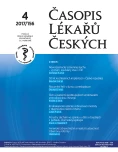-
Medical journals
- Career
Speech intelligibility in noise at presbycusis
Authors: Olga Dlouhá; Jan Vokřál; Libor Černý
Authors‘ workplace: Foniatrická klinika 1. LF UK a VFN v Praze
Published in: Čas. Lék. čes. 2017; 156: 183-186
Category: Original Article
Overview
Evaluation of speech recognition is possible by presenting testing material in sentence form with presence of competitive noise. We developed new test of sentence intelligibility in noise in the Czech language. This article demonstrates results of the influence of the babble noise on sentence intelligibility in hearing impaired listeners with presbycusis. The time characteristics of babble noise are similar to human voice. That is the reason why this noise masking is more enhanced at the central hearing level than any other noise masking. A group of 423 persons was divided into younger group (age from 40 to 65 years, N = 191, mean age 55.8 years.) and older group (age from 66 to 85 years, N = 232, mean age 75.4 years). For these two age groups, we compared the test performance in the subgroups stratified by the speech audiometry in silence. We demonstrate a statistically significant worse understanding of sentences in the older group against the younger group listening to sentences at level 65 dB SPL in competitive noise at level 65 dB SPL (p = 0.05). The development of the sentence intelligibility in noise test increased the possibilities of audiological examination by another test, which was up to now missing in the Czech language.
Keywords:
presbycusis, speech noise audiometry, speech intelligibility in noise
Sources
. Syka J. Presbyakuze. Otorinolaryngologie a foniatrie 2016; 65(4): 211–220.
2. Benichov J, Cox LC, Tun PA, Wingfield A. Word recognition within a linguistic context: effect of age, hearing acuity, verbal ability, and cognitive function. Ear Hear 2012; 33(2): 250–256.
3. Kollmeier B. Moderne Verfahren der Sprachaudiometrie. Band 1. Median-Verlag nach Killisch-Horn GmbH, Heidelberg, 1992.
4. Roeser RJ. Roeser’s audiology desk reference. A guide to the practice of audiology. Thieme, New York – Stuttgart, 1996.
5. Novák A. Audiologie. Vyšetřovací technika, diagnostika, léčba a rehabilitace. Unitisk, Praha, 2003.
6. Tremblay K, Ross B. Effects of age and age-related hearing loss on the brain. J Commun Disord 2007; 40 : 305–312.
7. Wilson RH, Cates WB. A comparison of two word-recognition tasks in multitalker babble: speech recognition in noise test (SPRINT) and words-in-noise test (WIN). J Am Acad Audiol 2008; 19(7): 548–556.
8. Wong PC, Jin JX, Gunasekera GM et al. Aging and cortical mechanisms of speech perception in noise. Neuropsychologia 2009; 47(3): 693–703.
9. Dlouhá O, Vokřál J. Test větné srozumitelnosti u osob s normálním sluchem. Otorinolaryngologie a foniatrie 2011; 60(3): 125–130.
10. Dlouhá O, Vokřál J, Černý L. Test větné srozumitelnosti v hovorovém šumu u osob s vadou sluchu. Otorinolaryngologie a foniatrie 2012; 61(4): 240–244.
Labels
Addictology Allergology and clinical immunology Angiology Audiology Clinical biochemistry Dermatology & STDs Paediatric gastroenterology Paediatric surgery Paediatric cardiology Paediatric neurology Paediatric ENT Paediatric psychiatry Paediatric rheumatology Diabetology Pharmacy Vascular surgery Pain management Dental Hygienist
Article was published inJournal of Czech Physicians

-
All articles in this issue
- Newborn hearing screening – importance, current state in the Czech Republic
- 30 years of the cochlear implantations in the Czech Republic
- Speech intelligibility in noise at presbycusis
- Olfactory function in patients undergoing FESS for chronic rhinosinusitis
- Endoscopic optical imaging methods in the diagnostics of the laryngeal cancer
- Sleep-related breathing disorders in children and adults from the aspect of the otorhinolaryngology
- Sore throat treatment
- American healthcare system and the uncertain future of the Obama’s reform
- Journal of Czech Physicians
- Journal archive
- Current issue
- Online only
- About the journal
Most read in this issue- Newborn hearing screening – importance, current state in the Czech Republic
- Sore throat treatment
- Sleep-related breathing disorders in children and adults from the aspect of the otorhinolaryngology
- 30 years of the cochlear implantations in the Czech Republic
Login#ADS_BOTTOM_SCRIPTS#Forgotten passwordEnter the email address that you registered with. We will send you instructions on how to set a new password.
- Career

